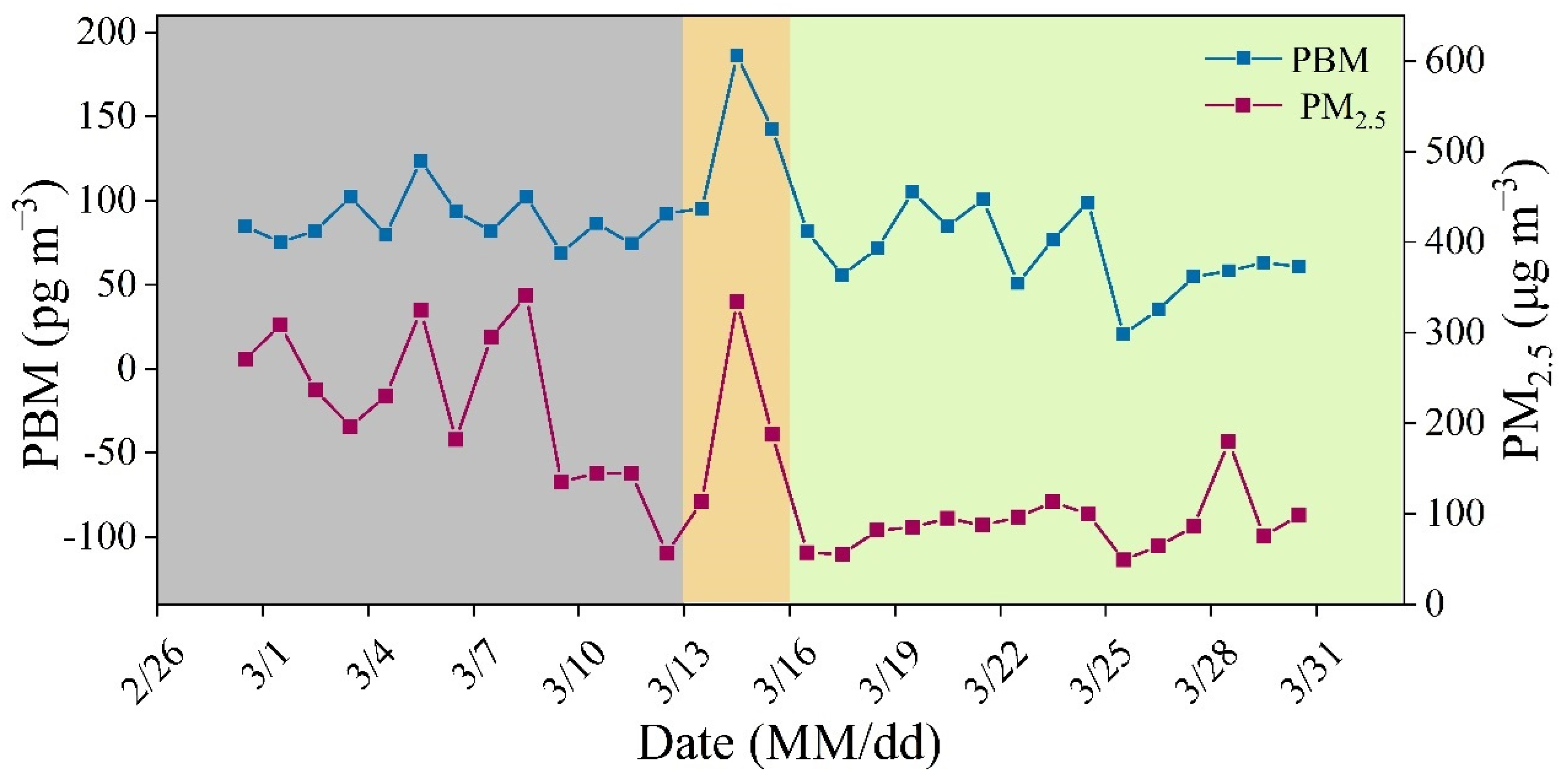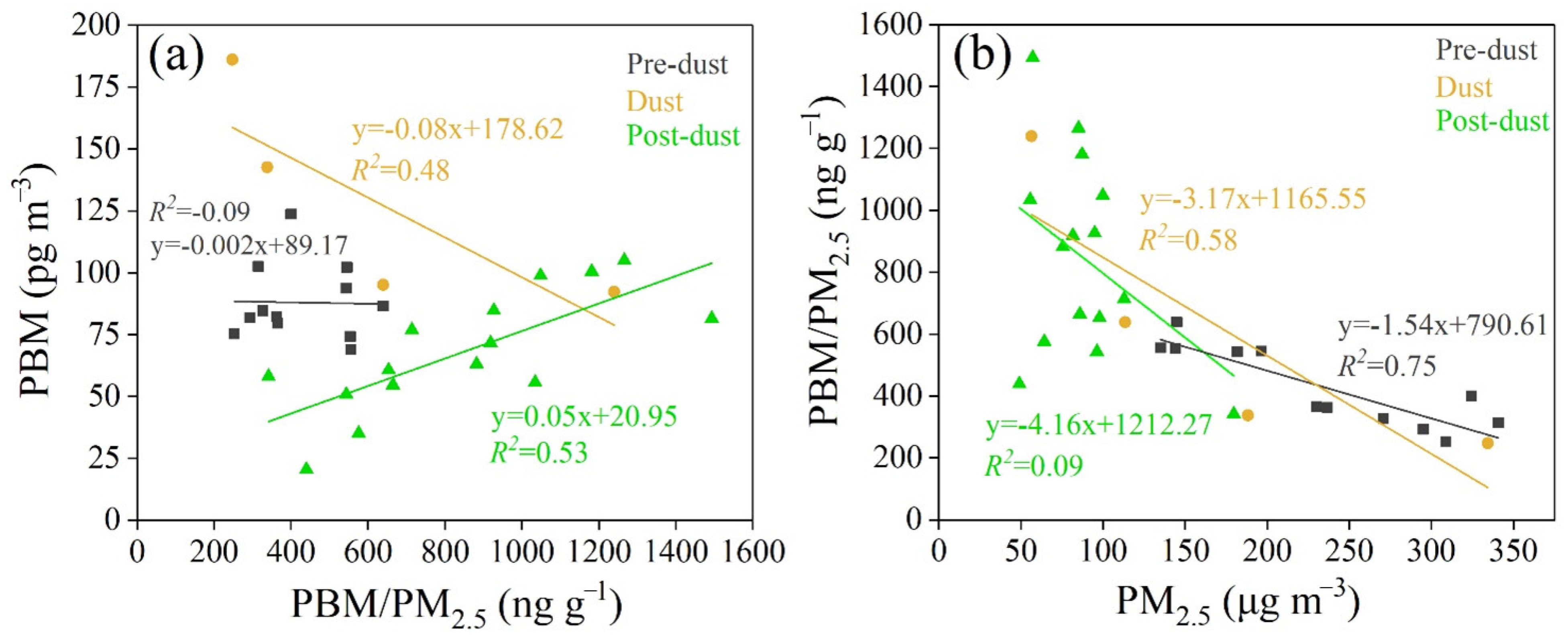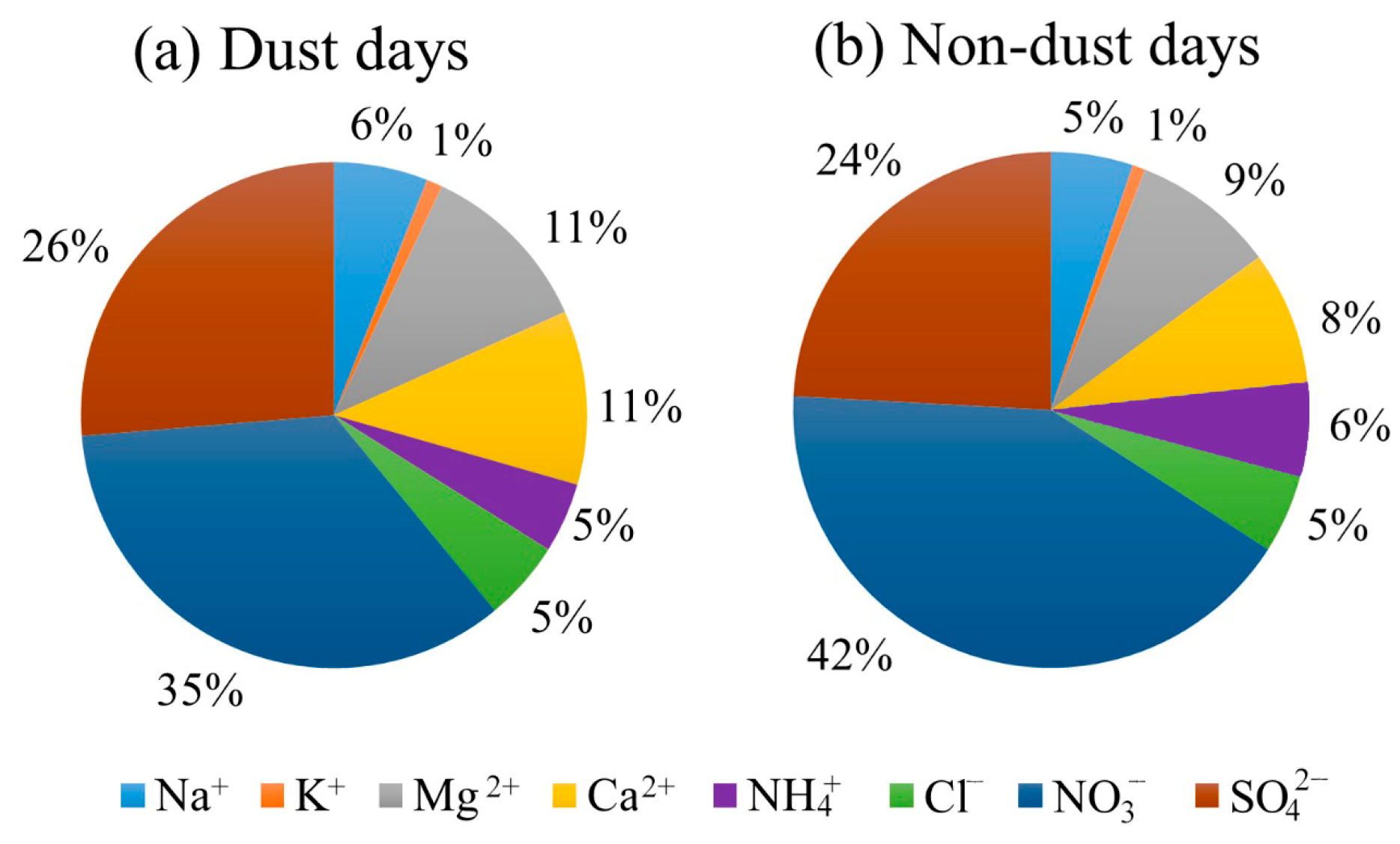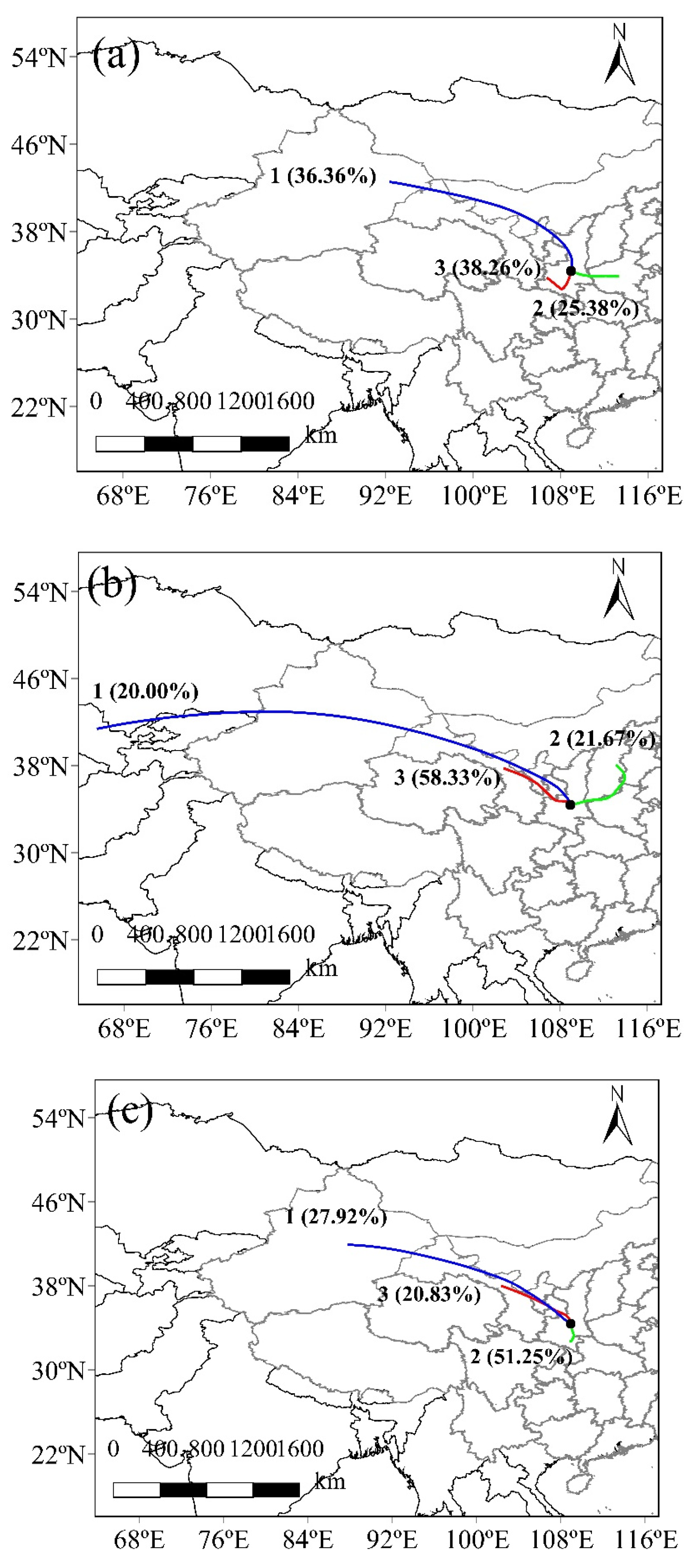Influence of Spring Dust Storm on Atmospheric Particulate-Bound Mercury in a Typical Inland City of Northern China: Characteristics, Sources, and Risk Assessment
Abstract
1. Introduction
2. Materials and Methods
2.1. Sample Collection
2.2. PM2.5 and PBM Concentration Analysis
2.3. Chemical Analysis
2.4. Source Analysis
2.5. Risk Assessment
3. Results and Discussion
3.1. Concentration of PBM
3.1.1. Characteristics of PBM Concentrations
3.1.2. Characteristics of Atmospheric PBM under Dust Days
3.1.3. Deposition of Atmospheric PBM
3.2. Effects of Natural and Anthropogenic Factors on Mercury Enrichment in PBM
3.3. Potential Pollution Source of PBM
3.3.1. Sources of the Invading Dust
3.3.2. Ratio of Trace Elements to Al in Dust Source
3.4. Risk Assessment
3.4.1. Environmental Risk
3.4.2. Human Health Risk
3.5. Quantification of Oral Ingestion Exposure Pathways to Mercury
4. Conclusions
Supplementary Materials
Author Contributions
Funding
Institutional Review Board Statement
Informed Consent Statement
Data Availability Statement
Conflicts of Interest
References
- Schroeder, W.H.; Munthe, J. Atmospheric mercury—An overview. Atmos. Environ. 1998, 32, 809–822. [Google Scholar] [CrossRef]
- U.S. EPA. Mercury Study Report to Congress; Office of Air Quality Planning and Standards and Office of Research and Development, US Environmental Protection Agency: Washington, DC, USA, 1997.
- Hammerschmidt, C.R.; Fitzgerald, W.F. Methylmercury in freshwater fish linked to atmospheric mercury deposition. Environ. Sci. Technol. 2006, 40, 7764–7770. [Google Scholar] [CrossRef] [PubMed]
- Cohen, M.; Artz, R.; Draxler, R.; Miller, P.; Poissant, L.; Niemi, D.; Ratte, D.; Deslauriers, M.; Duval, R.; Laurin, R.; et al. Modeling the atmospheric transport and deposition of mercury to the Great Lakes. Environ. Res. 2004, 95, 247–265. [Google Scholar] [CrossRef] [PubMed]
- Lu, J.; Schroeder, W. Sampling and determination of particulate mercury in ambient air: A review. Water Air Soil Pollut. 1999, 112, 279–295. [Google Scholar] [CrossRef]
- Lindberg, S.; Brooks, S.; Lin, C.; Scott, K.; Meyers, T.; Chambers, L.; Landis, M.; Stevens, R. Formation of reactive gaseous mercury in the Arctic: Evidence of oxidation of Hg to gas-phase Hg-II compounds after Arctic sunrise. Water Air Soil Pollut. Focus 2001, 1, 295–302. [Google Scholar] [CrossRef]
- Zhang, H.; Fu, X.; Wang, X.; Feng, X. Measurements and distribution of atmospheric particulate-bound mercury: A review. Bull. Environ. Contam. Toxicol. 2019, 103, 48–54. [Google Scholar] [CrossRef] [PubMed]
- Streets, D.G.; Devane, M.K.; Lu, Z.; Bond, T.C.; Sunderland, E.M.; Jacob, D.J. All-time releases of mercury to the atmosphere from human activities. Environ. Sci. Technol. 2011, 45, 10485–10491. [Google Scholar] [CrossRef] [PubMed]
- Obrist, D. Atmospheric mercury pollution due to losses of terrestrial carbon pools? Biogeochemistry 2007, 85, 119–123. [Google Scholar] [CrossRef]
- Streets, D.G.; Hao, J.; Wu, Y.; Jiang, J.; Chan, M.; Tian, H.; Feng, X. Anthropogenic mercury emissions in China. Atmos. Environ. 2005, 39, 7789–7806. [Google Scholar] [CrossRef]
- Wilson, S.J.; Steenhuisen, F.; Pacyna, J.M.; Pacyna, E.G. Mapping the spatial distribution of global anthropogenic mercury atmospheric emission inventories. Atmos. Environ. 2006, 40, 4621–4632. [Google Scholar] [CrossRef]
- Pacyna, E.G.; Pacyna, J.; Sundseth, K.; Munthe, J.; Kindbom, K.; Wilson, S.; Steenhuisen, F.; Maxson, P. Global emission of mercury to the atmosphere from anthropogenic sources in 2005 and projections to 2020. Atmos. Environ. 2010, 44, 2487–2499. [Google Scholar] [CrossRef]
- Pacyna, E.G.; Pacyna, J.M.; Steenhuisen, F.; Wilson, S. Global anthropogenic mercury emission inventory for 2000. Atmos. Environ. 2006, 40, 4048–4063. [Google Scholar] [CrossRef]
- Pirrone, N.; Cinnirella, S.; Feng, X.; Finkelman, R.B.; Friedli, H.R.; Leaner, J.; Mason, R.; Mukherjee, A.B.; Stracher, G.B.; Streets, D.; et al. Global mercury emissions to the atmosphere from anthropogenic and natural sources. Atmos. Chem. Phys. 2010, 10, 5951–5964. [Google Scholar] [CrossRef]
- Wu, Y.; Wang, S.; Streets, D.G.; Hao, J.; Chan, M.; Jiang, J. Trends in anthropogenic mercury emissions in China from 1995 to 2003. Environ. Sci. Technol. 2006, 40, 5312–5318. [Google Scholar] [CrossRef] [PubMed]
- Jiang, J.; Hao, J.; Wu, Y.; Duan, L.; Tian, H. Preliminary study on atmospheric mercury emission and control in China. Environ. Sci. Technol. 2005, 26, 34–39. (In Chinese) [Google Scholar]
- Wu, C.; Wang, G.; Cao, C.; Li, J.; Li, J.; Wu, F.; Huang, R.; Cao, J.; Han, Y.; Ge, S.; et al. Chemical characteristics of airborne particles in Xi’an, inland China during dust storm episodes: Implications for heterogeneous formation of ammonium nitrate and enhancement of N-deposition. Environ. Pollut. 2019, 244, 877–884. [Google Scholar] [CrossRef] [PubMed]
- Leaitch, W.; Macdonald, A.; Anlauf, K.; Liu, P.; Toom-Sauntry, D.; Li, S.; Liggio, J.; Hayden, K.; Wasey, M.; Russell, L.; et al. Evidence for Asian dust effects from aerosol plume measurements during INTEX-B 2006 near Whistler, BC. Atmos. Chem. Phys. 2008, 8, 18531–18589. [Google Scholar] [CrossRef]
- VanCuren, R.A.; Cahill, T.A. Asian aerosols in North America: Frequency and concentration of fine dust. J. Geophys. Res.—Atmos. 2002, 107, AAC 19-1–AAC 19-16. [Google Scholar] [CrossRef]
- Cao, J.; Lee, S.; Zhang, X.; Chow, J.C.; An, Z.; Ho, K.; Watson, J.G.; Fung, K.; Wang, Y.; Shen, Z. Characterization of airborne carbonate over a site near Asian dust source regions during spring 2002 and its climatic and environmental significance. J. Geophys. Res.-Atmos. 2005, 110, D03203. [Google Scholar] [CrossRef]
- Zhang, Q.; Shen, Z.; Cao, J.; Ho, K.; Zhang, R.J.; Bie, Z.; Chang, H.; Liu, S. Chemical profiles of urban fugitive dust over Xi’an in the south margin of the Loess Plateau, China. Atmos. Pollut. Res. 2014, 5, 421–430. [Google Scholar] [CrossRef]
- Wang, Y.; Zhuang, G.; Sun, Y.; An, Z. The variation of characteristics and formation mechanisms of aerosols in dust, haze, and clear days in Beijing. Atmos. Environ. 2006, 40, 6579–6591. [Google Scholar] [CrossRef]
- Li, Y.; Wang, Y.; Li, Y.; Li, T.; Mao, H.; Talbot, R.; Nie, X.; Wu, C.; Zhao, Y.; Hou, C.; et al. Characteristics and potential sources of atmospheric particulate mercury in Jinan, China. Sci. Total Environ. 2017, 574, 1424–1431. [Google Scholar] [CrossRef] [PubMed]
- Fu, X.; Feng, X.; Qiu, G.; Shang, L.; Zhang, H. Speciated atmospheric mercury and its potential source in Guiyang, China. Atmos. Environ. 2011, 45, 4205–4212. [Google Scholar] [CrossRef]
- Turnbull, A.B.; Harrison, R.M. Major component contributions to PM10 composition in the UK atmosphere. Atmos. Environ. 2000, 34, 3129–3137. [Google Scholar] [CrossRef]
- Filonchyk, M.; Peterson, M.P.; Zhang, L.; Yan, H. An analysis of air pollution associated with the 2023 sand and dust storms over China: Aerosol properties and PM10 variability. Geosci. Front. 2024, 15, 101762. [Google Scholar] [CrossRef]
- Liu, J.; Scheuer, E.; Dibb, J.; Ziemba, L.D.; Thornhill, K.; Anderson, B.E.; Wisthaler, A.; Mikoviny, T.; Devi, J.J.; Bergin, M.; et al. Brown carbon in the continental troposphere. Geophys. Res. Lett. 2014, 41, 2191–2195. [Google Scholar] [CrossRef]
- Steding, D.J.; Flegal, A.R. Mercury concentrations in coastal California precipitation: Evidence of local and trans-Pacific fluxes of mercury to North America. J. Geophys. Res.—Atmos. 2002, 107, ACH 11-1–ACH 11-7. [Google Scholar] [CrossRef]
- Shukla, A.K.; Lalchandani, V.; Bhattu, D.; Dave, J.S.; Rai, P.; Thamban, N.M.; Mishra, S.; Gaddamidi, S.; Tripathi, N.; Vats, P.; et al. Real-time quantification and source apportionment of fine particulate matter including organics and elements in Delhi during summertime. Atmos. Environ. 2021, 261, 118598. [Google Scholar] [CrossRef]
- Tian, L.; Li, J.; Zhao, S.; Tang, J.; Li, J.; Guo, H.; Liu, X.; Zhong, G.; Xu, Y.; Lin, T.; et al. DDT, Chlordane, and Hexachlorobenzene in the air of the pearl river delta revisited: A tale of source, history, and monsoon. Environ. Sci. Technol. 2021, 55, 9740–9749. [Google Scholar] [CrossRef]
- Hakanson, L. An ecological risk index for aquatic pollution control. A sedimentological approach. Water Res. 1980, 14, 975–1001. [Google Scholar] [CrossRef]
- Keeler, G.; Glinsorn, G.; Pirrone, N. Particulate mercury in the atmosphere: Its significance, transport, transformation and sources. Water Air Soil Pollut. 1995, 80, 159–168. [Google Scholar] [CrossRef]
- Bo, D.; Cheng, J.; Xie, H.; Zhao, W.; Wei, Y.; Chen, X. Mercury concentration in fine atmospheric particles during haze and non-haze days in Shanghai, China. Atmos. Pollut. Res. 2016, 7, 348–354. [Google Scholar] [CrossRef]
- Yu, B.; Yang, L.; Liu, H.; Xiao, C.; Bu, D.; Zhang, Q.; Fu, J.; Zhang, Q.; Cong, Z.; Liang, Y.; et al. Tracing the transboundary transport of mercury to the Tibetan Plateau using atmospheric mercury isotopes. Environ. Sci. Technol. 2022, 56, 1568–1577. [Google Scholar] [CrossRef] [PubMed]
- Yu, G.; Qin, X.; Xu, J.; Zhou, Q.; Wang, B.; Huang, K.; Deng, C. Characteristics of particulate-bound mercury at typical sites situated on dust transport paths in China. Sci. Total Environ. 2019, 648, 1151–1160. [Google Scholar] [CrossRef] [PubMed]
- Fu, X.; Feng, X.; Liang, P.; Deliger; Zhang, H.; Ji, J.; Liu, P. Temporal trend and sources of speciated atmospheric mercury at Waliguan GAW station, Northwestern China. Atmos. Chem. Phys. 2012, 12, 1951–1964. [Google Scholar] [CrossRef]
- Fu, X.; Feng, X.; Zhu, W.; Zheng, W.; Wang, S.; Lu, J.Y. Total particulate and reactive gaseous mercury in ambient air on the eastern slope of the Mt. Gongga area, China. Appl. Geochem. 2008, 23, 408–418. [Google Scholar] [CrossRef]
- Nguyen, L.S.P.; Hien, T.T.; Truong, M.T.; Chi, N.D.T.; Sheu, G.R. Atmospheric particulate-bound mercury (PBM10) in a Southeast Asia megacity: Sources and health risk assessment. Chemosphere 2022, 307, 135707. [Google Scholar] [CrossRef] [PubMed]
- Guo, J.; Kang, S.; Huang, J.; Zhang, Q.; Rupakheti, M.; Sun, S.; Tripathee, L.; Rupakheti, D.; Panday, A.K.; Sillanpää, M.; et al. Characterizations of atmospheric particulate-bound mercury in the Kathmandu Valley of Nepal, South Asia. Sci. Total Environ. 2017, 579, 1240–1248. [Google Scholar] [CrossRef]
- Brooks, S.; Luke, W.; Cohen, M.; Kelly, P.; Lefer, B.; Rappenglück, B. Mercury species measured atop the Moody Tower TRAMP site, Houston, Texas. Atmos. Environ. 2010, 44, 4045–4055. [Google Scholar] [CrossRef]
- Pyta, H.; Widziewicz-Rzońca, K.; Słaby, K. Inhalation exposure to gaseous and particulate bound mercury present in the ambient air over the polluted area of southern Poland. Int. J. Environ. Res. Public Health 2020, 17, 4999. [Google Scholar] [CrossRef]
- Song, X.; Cheng, I.; Lu, J. Annual atmospheric mercury species in downtown Toronto, Canada. J. Environ. Monit. 2009, 11, 660–669. [Google Scholar] [CrossRef] [PubMed]
- Moreda-Piñeiro, J.; Rodríguez-Cabo, A.; Fernández-Amado, M.; Piñeiro-Iglesias, M.; Muniategui-Lorenzo, S.; López-Mahía, P. Levels and sources of atmospheric particle-bound mercury in atmospheric particulate matter (PM10) at several sites of an Atlantic Coastal European Region. Atmosphere 2019, 11, 33. [Google Scholar] [CrossRef]
- Sun, R.; Sun, G.; Kwon, S.Y.; Feng, X.; Kang, S. Mercury biogeochemistry over the Tibetan Plateau: An overview. Crit. Rev. Environ. Sci. Technol. 2021, 51, 577–602. [Google Scholar] [CrossRef]
- Xiu, G.L.; Jin, Q.; Zhang, D.; Shi, S.; Huang, X.; Zhang, W.; Bao, L.; Gao, P.; Chen, B. Characterization of size-fractionated particulate mercury in Shanghai ambient air. Atmos. Environ. 2005, 39, 419–427. [Google Scholar] [CrossRef]
- Das, R.; Wang, X.; Khezri, B.; Webster, R.D.; Sikdar, P.K.; Datta, K. Mercury isotopes of atmospheric particle bound mercury for source apportionment study in urban Kolkata, India. Elementa 2016, 4, 000098. [Google Scholar] [CrossRef]
- Lynam, M.M.; Dvonch, J.T.; Hall, N.L.; Morishita, M.; Barres, J.A. Spatial patterns in wet and dry deposition of atmospheric mercury and trace elements in central Illinois, USA. Environ. Sci. Pollut. Res. 2014, 21, 4032–4043. [Google Scholar] [CrossRef] [PubMed]
- Dai, Z.H.; Feng, X.B.; Sommar, J.; Li, P.; Fu, X.W. Spatial distribution of mercury deposition fluxes in Wanshan Hg mining area, Guizhou province, China. Atmos. Chem. Phys. 2012, 12, 6207–6218. [Google Scholar] [CrossRef]
- Zhang, Y.; Liu, R.; Wang, Y.; Cui, X.; Qi, J. Change characteristic of atmospheric particulate mercury during dust weather of spring in Qingdao, China. Atmos. Environ. 2015, 102, 376–383. [Google Scholar] [CrossRef]
- Zhang, H.; Fu, X.W.; Lin, C.J.; Wang, X.; Feng, X.B. Observation and analysis of speciated atmospheric mercury in Shangri-La, Tibetan Plateau, China. Atmos. Chem. Phys. 2015, 15, 653–665. [Google Scholar] [CrossRef]
- Duan, L.; Cheng, N.; Xiu, G.; Wang, F.; Chen, Y. Characteristics and source appointment of atmospheric particulate mercury over East China Sea: Implication on the deposition of atmospheric particulate mercury in marine environment. Environ. Pollut. 2017, 224, 26–34. [Google Scholar] [CrossRef]
- Shen, Z.; Cao, J.; Arimoto, R.; Han, Z.; Zhang, R.J.; Han, Y.; Liu, S.; Okuda, T.; Nakao, S.; Tanaka, S. Ionic composition of TSP and PM2.5 during dust storms and air pollution episodes at Xi’an, China. Atmos. Environ. 2009, 43, 2911–2918. [Google Scholar] [CrossRef]
- Tang, M.; Cziczo, D.J.; Grassian, V.H. Interactions of water with mineral dust aerosol: Water adsorption, hygroscopicity, cloud condensation, and ice nucleation. Chem. Rev. 2016, 116, 4205–4259. [Google Scholar] [CrossRef] [PubMed]
- Chow, J.C.; Watson, J.G.; Kuhns, H.; Etyemezian, V.; Lowenthal, D.H.; Crow, D.; Kohl, S.D.; Engelbrecht, J.P.; Green, M.C. Source profiles for industrial, mobile, and area sources in the Big Bend Regional Aerosol Visibility and Observational study. Chemosphere 2004, 54, 185–208. [Google Scholar] [CrossRef] [PubMed]
- Jacobs, J.; Kreutzer, R.; Smith, D. Rice burning and asthma hospitalizations, Butte County, California, 1983-1992. Environ. Health Perspect. 1997, 105, 980–985. [Google Scholar] [CrossRef] [PubMed][Green Version]
- Huang, F.; Zhou, J.; Chen, N.; Li, Y.; Li, K.; Wu, S. Chemical characteristics and source apportionment of PM2.5 in Wuhan, China. J. Atmos. Chem. 2019, 76, 245–262. [Google Scholar] [CrossRef]
- Shen, R.; Schäfer, K.; Shao, L.; Schnelle-Kreis, J.; Wang, Y.; Li, F.; Liu, Z.; Emeis, S.; Schmid, H.P. Chemical characteristics of PM2.5 during haze episodes in spring 2013 in Beijing. Urban Clim. 2017, 22, 51–63. [Google Scholar] [CrossRef]
- Li, R.; Zhang, M.; Du, Y.; Wang, G.; Shang, C.; Liu, Y.; Zhang, M.; Meng, Q.; Cui, M.; Yan, C. Impacts of dust events on chemical characterization and associated source contributions of atmospheric particulate matter in northern China. Environ. Pollut. 2023, 316, 120597. [Google Scholar] [CrossRef] [PubMed]
- Xu, L.; Chen, J.; Niu, Z.; Yin, L.; Chen, Y. Characterization of mercury in atmospheric particulate matter in the southeast coastal cities of China. Atmos. Pollut. Res. 2013, 4, 454–461. [Google Scholar] [CrossRef]
- Yang, L.; Zhang, S.; Huang, Z.; Yang, Y.; Wang, L.; Han, W.; Li, X.Y. Characteristics of Dust Events in China from 2015 to 2020. Atmosphere 2021, 12, 952. [Google Scholar] [CrossRef]
- Yin, X.; Zhou, W.; Kang, S.; de Foy, B.; Yu, Y.; Xie, J.; Sun, S.; Wu, K.; Zhang, Q. Latest observations of total gaseous mercury in a megacity (Lanzhou) in northwest China. Sci. Total Environ. 2020, 720, 137494. [Google Scholar] [CrossRef]
- Lindberg, S.; Bullock, R.; Ebinghaus, R.; Engstrom, D.; Feng, X.; Fitzgerald, W.; Pirrone, N.; Prestbo, E.; Seigneur, C. A synthesis of progress and uncertainties in attributing the sources of mercury in deposition. AMBIO 2007, 36, 19–33. [Google Scholar] [CrossRef]
- CNEMC. Background Abundance of Soil Elements in China; China National Environmental Monitoring Centre: Beijing, China, 1990. (In Chinese) [Google Scholar]
- Shen, Z.; Cao, J.; Arimoto, R.; Zhang, R.J.; Jie, D.; Liu, S.; Zhu, C. Chemical composition and source characterization of spring aerosol over Horqin sand land in northeastern China. J. Geophys. Res. 2007, 112, D14315. [Google Scholar] [CrossRef]
- Cao, J.; Chow, J.; Watson, J.; Wu, F.; Han, Y.; Jin, Z.; Shen, Z.; An, Z. Size-differentiated source profiles for fugitive dust in the Chinese Loess Plateau. Atmos. Environ. 2008, 42, 2261–2275. [Google Scholar] [CrossRef]
- Wang, Q.; Zhuang, G.; Li, J.; Huang, K.; Zhang, R.J.; Jiang, Y.; Lin, Y.; Fu, J.S. Mixing of dust with pollution on the transport path of Asian dust—Revealed from the aerosol over Yulin, the north edge of Loess Plateau. Sci. Total Environ. 2011, 409, 573–581. [Google Scholar] [CrossRef] [PubMed]
- Huang, S.; Tu, J.; Liu, H.; Hua, M.; Liao, Q.; Feng, J.; Weng, Z.; Huang, G. Multivariate analysis of trace element concentrations in atmospheric deposition in the Yangtze River Delta, East China. Atmos. Environ. 2009, 43, 5781–5790. [Google Scholar] [CrossRef]
- Huang, M.; Chen, X.; Shao, D.; Zhao, Y.; Wang, W.; Wong, M.H. Risk assessment of arsenic and other metals via atmospheric particles, and effects of atmospheric exposure and other demographic factors on their accumulations in human scalp hair in urban area of Guangzhou, China. Ecotoxicol. Environ. Saf. 2014, 102, 84–92. [Google Scholar] [CrossRef] [PubMed]
- Sah, D.; Verma, P.K.; Kandikonda, M.K.; Lakhani, A. Pollution characteristics, human health risk through multiple exposure pathways, and source apportionment of heavy metals in PM10 at Indo-Gangetic site. Urban Clim. 2019, 27, 149–162. [Google Scholar] [CrossRef]
- Cui, L.; Wu, Z.; Han, P.; Taira, Y.; Wang, H.; Meng, Q.; Feng, Z.; Zhai, S.; Yu, J.; Zhu, W.; et al. Chemical content and source apportionment of 36 heavy metal analysis and health risk assessment in aerosol of Beijing. Environ. Sci. Pollut. Res. 2020, 27, 7005–7014. [Google Scholar] [CrossRef] [PubMed]
- Lu, X.; Wu, X.; Wang, Y.; Chen, H.; Gao, P.; Fu, Y. Risk assessment of toxic metals in street dust from a medium-sized industrial city of China. Ecotoxicol. Environ. Saf. 2014, 106, 154–163. [Google Scholar] [CrossRef] [PubMed]
- Fang, F.; Wang, Q.; Liu, R.; Ma, Z.; Hao, Q. Atmospheric particulate mercury in Changchun city, China. Atmos. Environ. 2001, 35, 4265–4272. [Google Scholar] [CrossRef]
- Lyman, S.N.; Gustin, M.S.; Prestbo, E.M.; Marsik, F.J. Estimation of dry deposition of atmospheric mercury in Nevada by direct and indirect methods. Environ. Sci. Technol. 2007, 41, 1970–1976. [Google Scholar] [CrossRef]
- Huang, J.; Kang, S.; Guo, J.; Zhang, Q.; Cong, Z.; Sillanpää, M.; Zhang, G.; Sun, S.; Tripathee, L. Atmospheric particulate mercury in Lhasa city, Tibetan Plateau. Atmos. Environ. 2016, 142, 433–441. [Google Scholar] [CrossRef]
- Polissar, A.V.; Hopke, P.K.; Harris, J.M. Source regions for atmospheric aerosol measured at Barrow, Alaska. Environ. Sci. Technol. 2001, 35, 4214–4226. [Google Scholar] [CrossRef] [PubMed]
- Wang, Y.; Zhang, X.; Arimoto, R. The contribution from distant dust sources to the atmospheric particulate matter loadings at Xi’an, China during spring. Sci. Total Environ. 2006, 368, 875–883. [Google Scholar] [CrossRef] [PubMed]
- Zhang, X.; Eto, Y.; Aikawa, M. Risk assessment and management of PM2.5-bound heavy metals in the urban area of Kitakyushu, Japan. Sci. Total Environ. 2021, 795, 148748. [Google Scholar] [CrossRef]
- Li, H.; Chen, Q.; Wang, C.; Wang, R.; Sha, T.; Yang, X.; Ainur, D. Pollution characteristics of environmental persistent free radicals (EPFRs) and their contribution to oxidation potential in road dust in a large city in northwest China. J. Hazard. Mater. 2023, 442, 130087. [Google Scholar] [CrossRef] [PubMed]
- Wei, M.; Zhang, X.; Zhang, K.; Ussher, S.J.; Lu, W.; Li, J.; Meng, F. The characteristics of atmospheric particles and metal elements during winter in BeiJing: Size distribution, source analysis, and environmental risk assessment. Ecotoxicol. Environ. Saf. 2021, 211, 111937. [Google Scholar] [CrossRef] [PubMed]
- Schleicher, N.; Schäfer, J.; Blanc, G.; Chen, Y.; Chai, F.; Cen, K.; Norra, S. Atmospheric particulate mercury in the megacity Beijing: Spatio-temporal variations and source apportionment. Atmos. Environ. 2015, 109, 251–261. [Google Scholar] [CrossRef]
- Kim, P.R.; Han, Y.J.; Holsen, T.M.; Yi, S.M. Atmospheric particulate mercury: Concentrations and size distributions. Atmos. Environ. 2012, 61, 94–102. [Google Scholar] [CrossRef]
- Sakata, M.; Marumoto, K. Formation of atmospheric particulate mercury in the Tokyo metropolitan area. Atmos. Environ. 2002, 36, 239–246. [Google Scholar] [CrossRef]
- USEPA. Supplemental Guidance for Developing Soil Screening Levels for Superfund Sites; Peer Review Draft; Office of Solid Waste and Emergency Response (OSWER): Washington, DC, USA, 2001; Volume 9355, pp. 4–24.
- Jiang, N.; Liu, X.; Wang, S.; Yu, X.; Yin, S.; Duan, S.; Wang, S.; Zhang, R.; Li, S. Pollution characterization, source identification, and health risks of atmospheric-particle-bound heavy metals in PM10 and PM2.5 at multiple sites in an emerging megacity in the central region of China. Aerosol Air Qual. Res. 2019, 19, 247–271. [Google Scholar] [CrossRef]
- USEPA. Human Health Evaluation Manual. In Risk Assessment Guidance for Superfund; Office of Soild Waste and Emergency Response: Washington, DC, USA, 1989. [Google Scholar]
- Sun, G.; Li, Z.; Bi, X.; Chen, Y.; Lu, S.; Yuan, X. Distribution, sources and health risk assessment of mercury in kindergarten dust. Atmos. Environ. 2013, 73, 169–176. [Google Scholar] [CrossRef]
- Lei, L.; Liang, D.; Yu, D.; Chen, Y.; Song, W.; Li, J. Human health risk assessment of heavy metals in the irrigated area of Jinghui, Shaanxi, China, in terms of wheat flour consumption. Environ. Monit. Assess. 2015, 187, 647. [Google Scholar] [CrossRef] [PubMed]
- Li, G.; Su, H.; Duan, M.; Ma, W.; Sun, X. Analysis and evaluation of heavy metal pollution in vegetables in Xi’an City. Acta Bot. Boreali-Occident. Sin. 2008, 28, 1904–1909. (In Chinese) [Google Scholar]
- Ren, H.; Tian, Q.; Yang, Y.; Hou, S. Distribution characteristics and edible safety evaluation of heavy metals in aquatic products from Shaanxi Province. Anhui Agricul. Sci. 2017, 45, 81–84. [Google Scholar]







| Period | Date | PBM (pg m−3) (Mean ± SD) | PM2.5 (μg∙m−3) | PM10 (μg∙m−3) | PBM/PM2.5 (ng g−1) | Dry-Deposition (μg m−2) |
|---|---|---|---|---|---|---|
| Pre-dust | 3.1–3.12 | 87.97 ± 15.32 | 234.02 | 245.94 | 375.91 | 0.46 |
| Dust | 3.13–3.16 | 129.07 ± 44.48 | 173.07 | 333.55 | 745.77 | 0.22 |
| Post-dust | 3.17–3.31 | 67.92 ± 24.00 | 88.18 | 123.62 | 770.24 | 0.44 |
| Whole | 3.1–3.31 | 83.57 ± 30.97 | 155.59 | 171.27 | 537.71 | 1.12 |
| Period | Eri | Igeo | |
|---|---|---|---|
| Pre-dust | Mean value | 572.78 | 3.25 |
| Dust | Mean value | 821.54 | 3.77 |
| Maximum value | 1653.33 | 4.78 | |
| Minimum value | 333.33 | 2.47 | |
| Post-dust | Mean value | 1127.71 | 4.23 |
| Whole | 873.39 | 3.86 |
| Resident | Food Type | Maximum Intake (g day−1) | Minimum Intake (g day−1) | Average Intake (g day−1) |
|---|---|---|---|---|
| Children | Wheat flour | 139.85 | 27.97 | 73.94 |
| Leafy vegetables | 51.13 | 10.23 | 27.03 | |
| Solanaceous vegetables | 401.60 | 80.32 | 212.33 | |
| Aquatic products | 7.82 | 1.56 | 4.13 | |
| Adult | Wheat flour | 50 | 9.97 | 26.38 |
| Leafy vegetables | 18.28 | 3.65 | 9.64 | |
| Solanaceous vegetables | 143.58 | 28.63 | 75.76 | |
| Aquatic products | 2.79 | 0.56 | 1.48 |
Disclaimer/Publisher’s Note: The statements, opinions and data contained in all publications are solely those of the individual author(s) and contributor(s) and not of MDPI and/or the editor(s). MDPI and/or the editor(s) disclaim responsibility for any injury to people or property resulting from any ideas, methods, instructions or products referred to in the content. |
© 2024 by the authors. Licensee MDPI, Basel, Switzerland. This article is an open access article distributed under the terms and conditions of the Creative Commons Attribution (CC BY) license (https://creativecommons.org/licenses/by/4.0/).
Share and Cite
Li, X.; Zhang, R.; Tripathee, L.; Guo, J.; Yang, W.; Guo, J. Influence of Spring Dust Storm on Atmospheric Particulate-Bound Mercury in a Typical Inland City of Northern China: Characteristics, Sources, and Risk Assessment. Sustainability 2024, 16, 4096. https://doi.org/10.3390/su16104096
Li X, Zhang R, Tripathee L, Guo J, Yang W, Guo J. Influence of Spring Dust Storm on Atmospheric Particulate-Bound Mercury in a Typical Inland City of Northern China: Characteristics, Sources, and Risk Assessment. Sustainability. 2024; 16(10):4096. https://doi.org/10.3390/su16104096
Chicago/Turabian StyleLi, Xiaofei, Rui Zhang, Lekhendra Tripathee, Jingning Guo, Wen Yang, and Junming Guo. 2024. "Influence of Spring Dust Storm on Atmospheric Particulate-Bound Mercury in a Typical Inland City of Northern China: Characteristics, Sources, and Risk Assessment" Sustainability 16, no. 10: 4096. https://doi.org/10.3390/su16104096
APA StyleLi, X., Zhang, R., Tripathee, L., Guo, J., Yang, W., & Guo, J. (2024). Influence of Spring Dust Storm on Atmospheric Particulate-Bound Mercury in a Typical Inland City of Northern China: Characteristics, Sources, and Risk Assessment. Sustainability, 16(10), 4096. https://doi.org/10.3390/su16104096







